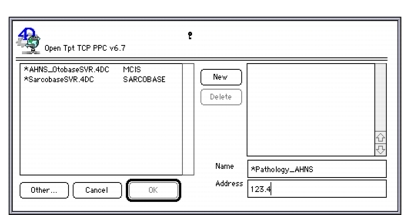

Installing Otobase Server for Macintosh
The following procedure will describe how to install Otobase Server for Macintosh.
To install Otobase ServerOnce you have installed the Otobase server files, you will next need to install the necessary 4D files. For more information on 4D files, see Obtaining 4D files.
Installing 4D Server
Once the Otobase Server is installed, you are now ready to install 4D Server. Follow the instructions for installing the server software and related files including the Network Components and 4D Write.
To run 4D Server using Otobase
- Browse to the folder 4D Server.
- Double-click on the 4Dserver application file.
- In the open dialog, make sure the Files of type pop-up is set to `Compiled Database (*.4DC).'
- Browse to the Otobase Server folder.
- Click on the OtobaseSVR file.
- Click Open.
- When a dialog prompts you to find the Otobase data file, do one of the following:
- If this is your first time working with Otobase, we highly recommend that you use the Example Data file. Find it in the Otobase root directory in the Example Data folder
- If you wish to create a new data file, click New, choose a name for the new file and click OK.
- If you wish to use an existing data file, browse to the file and click OK.
Using 4D Write
Some of Otobase's features, such as generating reminder letters, are enabled by a word processing program called 4D Write. The 4D Write license is included in stand-alone versions of Otobase. In a client/server environment, if you wish to use 4D Write you can purchase a license from 4D.

To install a license for 4D WriteConfiguring the client machine
The 4D Client software must be installed on each client machine that is connecting to the server. After downloading the client software from 4D or installing it from a disk, you will see the files in a folder called 4D Client. Before connecting to the server, you will need to move this folder to the hard drive.
To connect to a serverNote: If the server is not visible, see "To manually connect to the server" below.To manually connect to the server
- If you do not see the server you wish to connect to, click the key icon in the upper right-hand corner.
The screen enlarges and allows you to manually search for the running 4D Server

.- Next to Name, type in a nickname for the server you are looking for, such as Pathology_AHNS.
- Enter the IP address for the computer running the server and click New and the name you gave the server appears in the upper screen.
- Double-click the server name.
- After you connect to the server, a dialog requests you to log on. Enter your user name and password.
Note: If the server has been used in the past, it's name will appear in the list. Double click on the server's name to establish a connectionConnecting to an encrypted server
If the server you are connecting to is encrypted, an asterisk (*) needs to precede the server's name.
This indicates that the server is encrypted and you can only access it if you are using a TCP/IP connection.

Servers on your local network will automatically display the asterisk in their names. To manually connect to an encrypted server, you will need to precede the server nickname with an asterisk.
To manually connect to an encrypted server
|
Otobase Otobase Web Site Voice: (206) 221-2430 Fax: (206) 221-5152 otobase@u.washington.edu |